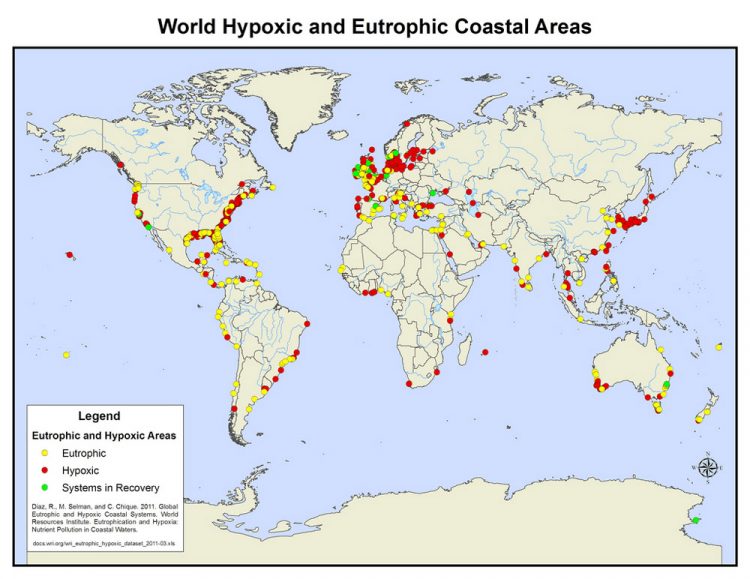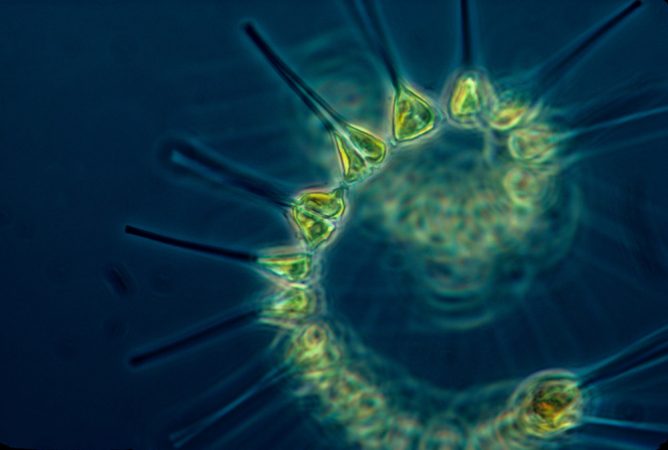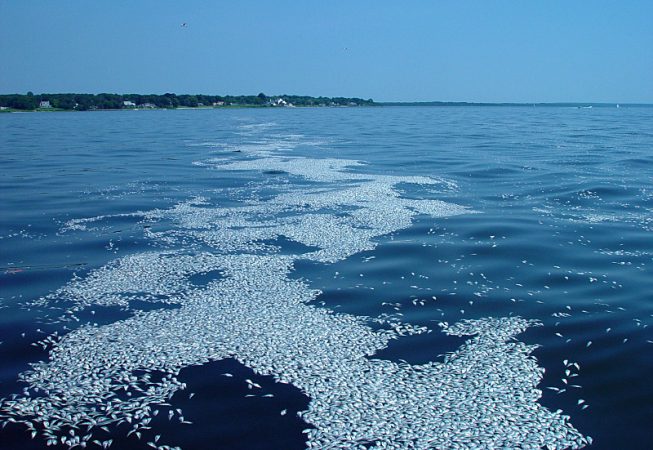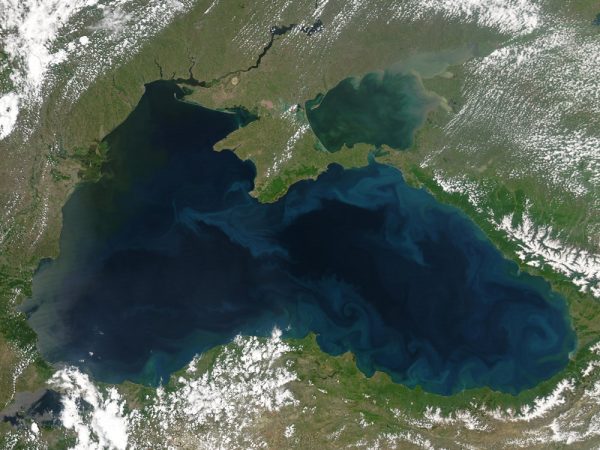Suffocating waters
Coastal animals around the world are spending more time in or around waters with too little oxygen

This map shows dead zones (red) areas where excess nutrients might allow dead zones to develop (yellow). In some parts of the world, areas that had dead zones are getting better (green).
R. Diaz et al/World Resources Institute 2011
Take a deep breath and hold it for 30 seconds.
Now you know what it’s like for fish in a coastal dead zone, a place where there’s little or no oxygen in the water, says Robert Diaz. He’s a researcher at the Virginia Institute of Marine Science in Gloucester Point.
You can catch your breath after 30 seconds. But in a dead zone animals can’t. So fish, crabs and other critters that enter a dead zone will quickly leave. Sea life that can’t swim away may suffocate. “This is how dead zones get their name,” Diaz explains.
Since 1994, he and the World Resources Institute in Washington,D.C., have identified and mapped 479 dead zones around the world. That’s more than nine times as many as scientists knew about 50 years ago.
What triggers the loss of oxygen in ocean water is the explosive growth of sea life fueled by the release of too many nutrients. As they grow, these crowds can simply use up too much of the available oxygen.
Many nutrients entering the water — such as nitrogen and phosphorus — come from meeting the daily needs of some seven billion people around the world, Diaz says. Crop fertilizers, manure, sewage and exhaust spewed by cars and power plants all end up in waterways that flow into the ocean. Each can contribute to the creation of dead zones.
Upstreamers pollute downstreamers
Rainwater drips over rooftops, drains down gutters and flows over parking lots. It washes through crop fields, animal farms and sewage treatment plants. It courses through streams that feed into small rivers. The small rivers wash into bigger rivers that flow into coastal areas such as bays and estuaries. (An estuary is a partially enclosed body of water where a river meets the ocean.)
Along the way, this water collects nutrient-rich fertilizers, sewage and pollutants — all of which amount to plant food.

Phytoplankton are tiny one-celled plants and plant-like organisms such as algae. They float in the water. Individual phytoplankton are too small to see without a microscope. But they can grow by the millions to form “blooms” in the ocean that are visible from space. These colorful blooms sometimes trigger dead zones.
In a balanced ecosystem, tiny animals called zooplankton graze on phytoplankton. This keeps numbers of the plantlike plankton in check. But if too many nutrients flow into the water, the zooplankton won’t be able to keep up with the phytoplankton’s growth.
“Nutrients like phosphorus and nitrogen are good up to a point, but too much is bad,” explains Robert Howarth of Cornell University. He likens it to food for people. The right amount is healthy: Too much can foster excess growth and disease.
As phytoplankton die, they fall to the ocean floor. So does zooplankton poop. Bacteria — small, single-celled organisms — feed on both. To break down these wastes, the growing populations of bacteria will need oxygen. Their mushrooming growth can, therefore, rob large quantities of oxygen from big patches of the coastal ocean.
Mixing needed
Ordinarily, when bacteria steal oxygen from one patch of water, more will arrive as waves and ocean currents bring new water in. Waves also can grab oxygen from the atmosphere.
Dead zones develop when this ocean mixing stops.
Rivers running into the sea dump freshwater into the salty ocean. The sun heats up the freshwater on the sea surface. This water is lighter than cold saltier water, so it floats atop it. When there are not enough storms (including hurricanes) and strong ocean currents to churn the water, the cold water can get trapped below the fresh water for long periods.

Without new supplies of oxygen-rich water, conditions in lower coastal waters — where bacteria are feeding — can become suffocating. Hypoxia (high POX ee ah) is what scientists call this state of low oxygen. When a large enough region develops hypoxia, a dead zone occurs.
Some marine animals, like jellyfish, can survive relatively low oxygen levels. Fish, crabs and shrimp don’t like it, so they leave. But moving out is not an option for worms, clams and other animals that are stuck in the sediment they have homesteaded. These creatures simply die if their neighborhood’s oxygen falls too low for too long.
Seasonal woes
Dead zones are seasonal events. They typically last for weeks or months. Then they’ll disappear as the weather changes and ocean mixing resumes.
One of the world’s largest dead zones develops in the Gulf of Mexico every spring and summer. Here the hypoxia can sprawl to embrace a patch of water the size of Lake Ontario, or some 17,000 square kilometers. In 2002, the Gulf’s dead zone swelled to its largest size ever: 22,000 square kilometers, or a region spanning an area about the size of Massachusetts.
Nutrients contributing to the Gulf’s dead zone come from throughout the Mississippi River basin. This region is immense. Rainwater from 31 states and southernCanada— and any pollutants it may pick up — eventually drain from this basin into the Mississippi River.
The Gulf’s dead zone doesn’t usually develop until March. This is when strong fall and winter storms that mix ocean water die down. It’s also when air temperatures begin to rise. Most importantly, it’s when the Mississippi River starts shipping into the Gulf huge amounts of nutrient-filled water from melting snow and ice throughout its basin.
Each year, Nancy Rabalais maps the impacts of these pollutants. A scientist with the Louisiana Universities Marine Consortium in Cocodrie, she cruises the Gulf of Mexico, measuring oxygen concentrations. In 2011, her team predicted that the Gulf dead zone would be a doozy. The reason: Flooding throughout the Midwest was sweeping record amounts of pollution towards the Gulf.
But the dead zone did not get as large as her team had expected. The reason: In July, tropical storm Don mixed the Gulf enough to resupply oxygen to much of its hypoxic coastal water. Also, the summer ocean current moved in an unusual pattern that served to shrink the size of the dead zone, Rabalais says.
“While its footprint wasn’t as large as we predicted,” she admits, the 2011 Gulf dead zone “was still very large.”
Some are natural
Not all dead zones are alike. Some low-oxygen areas need no help from people and pollution. Such natural dead zones form off the west coasts of North and South America and off southwest Africa.
In these areas, sea-surface winds push massive amounts of water away from the shore. That is replaced by deep, cold water that wells up towards the surface. The deep ocean waters are low in oxygen but full of nutrients. Once those nutrients reach the sunlit surface, they fuel huge phytoplankton blooms that can cover hundreds of square kilometers.
This normally occurs far from shore. But in 2002, fishermen near the coast of Oregon started to find dead crabs in their traps. It turned out that a dead zone had emerged. Every summer since then, scientists have recorded hypoxia developing relatively near to shore. Scientists are now trying to figure out what is causing it.
The two largest of these dead zones occurred in 2002 and 2006. Jack Barth Oregon State University in Corvallis likens the 2006 event to a wildfire. In some regions, oxygen values fell to zero, he says. This wiped out fish and invertebrates (animals without backbones) on a nearby rocky reef.
Since then, Barth and OSU colleague Francis Chan have scouted for signs that the reef community is recovering. And evidence is emerging. “We can see the slow reseeding of the invertebrates, like the anemones that are attached to the rocks,” Barth says.
But he expects large seasonal dead zones will continue to develop off the coasts Oregon and Washington for years to come. One theory as to why: Climate change is producing warmer layers of upper water that trap colder water below. These layers reduce ocean water mixing.
With less mixing, the large ocean currents that feed the upwelling in this region start off with even less oxygen than they used to. But other factors may also play a role. For instance, area winds and coastal waters have begun moving in new ways.
Helping dead zones recover
The Black Sea is bordered by Europe and Asia. Dead zones used to develop here that covered an area as large as Switzerland. Fertilizers running off of vast agricultural fields and animal feedlots in the former Soviet Union were a primary cause. Then, in 1989, parts of the Soviet Union began revolting. Two years later, this massive nation broke apart into 15 separate countries.
The political instability hurt farm activity. In short order, use of nitrogen and phosphorus fertilizers by area farmers declined. Almost at once, the size of the Black Sea’s dead zone shrunk dramatically. Now if a dead zone forms there it’s small, Rabalais says. Some years there is none.

Political upheaval is not a solution that scientists would recommend to cure dead zones, she acknowledges. But this situation does illustrate that reducing the flow of excess nutrients into rivers and bays can have an enormous benefit.
Chesapeake Bay, the United State’s largest estuary, has its own dead zone. And the area affected has expanded over the past 50 years due to pollution. But since the 1980s, farmers, landowners and government agencies have worked to reduce the nutrients flowing into the bay.
Farmers now plant cover crops, such as oats or barley, that use up fertilizer that once washed away into rivers. Growers have also established land buffers to absorb nutrient runoff and to keep animal waste out of streams. People have even started to use laundry detergents made without phosphorus.
In 2011, scientists reported that these efforts had achieved some success in shrinking the size of the bay’s late-summer dead zones.
The World Resources Institute lists 55 dead zones as improving. “The bottom line is if we take a look at what is causing a dead zone and fix it, then the dead zone goes away,” says Diaz. “It’s not something that has to be permanent.”
Power Words
(adapted from the New Oxford American Dictionary)
dead zone An area in the ocean where most or all of the oxygen has been used up.
estuaryA semi-enclosed body of water where freshwater, such as flow from rivers, meets the tide from the ocean.
phytoplanktonSingle-celled plants and plant-like organisms that float in the water.
zooplanktonTiny floating animals in the water that feed on phytoplankton.
bacteria Single-celled organisms that can live almost anywhere.
hypoxia The condition when oxygen is below the level necessary for plants and animals to survive.
upwelling A process that draws deep salty water that is rich in nutrients up to the ocean surface, replacing warmer surface waters that have been pushed offshore by winds.







